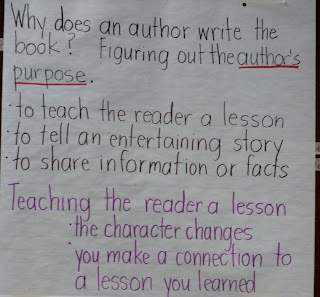Sooooooo...my little darlings are having a difficult time figuring out why the author wrote the book, and if he's trying to teach us a lesson. Planning is rough when you only have twenty minute increments to teach such a difficult concept, and for these students, I really have to model and break down the thinking process. So....here goes...gulp...
I first made an anchor chart with the direct teaching point that authors write for a reason:
In the future, we'll talk about how authors also write to persuade their audience...
Then I used my secret weapon...Mo Willems (a whole blog post dedicated to him will be forthcoming). Yes, I know I have a third grade audience, but I only have 20 minutes, and I need a short, versatile, highly engaging text whose purpose can be easily determined so the students feel some success when they try this strategy. Ergo, Elephant and Piggie. I read the book aloud, and I ask them, why do you think Mo Willems wrote the book. Most of them confidently select at least one of the two correct answers, and then we discuss evidence from the book that proves both of these reasons. I end my quick lesson with the fact that we will be focusing on the lessons that authors try to teach us.
Over the next couple of sessions, we read more Elephant and Piggie books, exploring what kinds of lessons Mo Willems is trying to teach us through these characters. We continue our charting the lessons that Mo Willems teaches us through his characters.
Finally, I channel some Debbie Miller and gradually release responsibility to the students: I model what they're going to do on this nifty graphic organizer, read aloud the story, and off they go.
I definitely want to revisit this concept with more complex texts, but here's hoping they they're excited to try thinking and writing about it during their independent reading!




This is great! A few of my own third graders struggle with this too! I will definitely try to remember this.
ReplyDelete